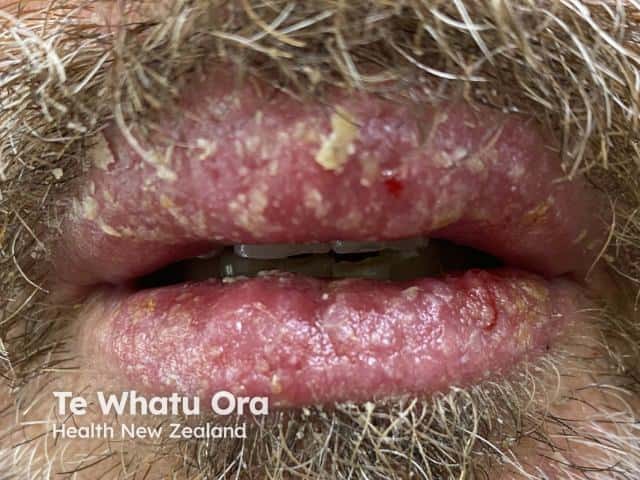Main menu
Common skin conditions

NEWS
Join DermNet PRO
Read more
Quick links
Last Reviewed: July, 2024
Authors: Dr Delwyn Dyall-Smith, FACD, Dermatologist (2010); review and minor update by Dr Selene Ting, Dermatology Registrar, Monash Medical Centre (2024).
Reviewing dermatologist: Dr Ian Coulson
Edited by the DermNet content department
Introduction
Demographics
Diagnosis
Treatment
Reported allergens
Irritant contact reactions
Discolouration of teeth
Oral hygiene products include toothpaste, dental floss, denture cleansers and mouthwashes. Contact reactions to oral hygiene products affect all age groups.
Toothpaste consists of flavourings, preservatives, solvents, surfactants, colouring agents, abrasives, thickening agents, detergents, buffers, humectants, antiseptics, antacids, and fluoride salts. Flavourings are the major cause of allergic reactions to toothpaste and there is considerable overlap with foods.
Toothpaste and other oral hygiene products can cause cheilitis (inflamed lips) and stomatitis (inflamed mouth). Specific adverse reactions include:
Such reactions are however fortunately rare considering how commonly and frequently these products are used.

Contact cheilitis due to propolis in toothpaste
Allergic reactions to oral hygiene ingredients are rare, probably due to the rinsing after use. Approximately 30 potential allergens have been identified in toothpastes and these are present in most toothpaste products.
Females present more commonly than males with an allergic contact reaction to toothpaste and other oral hygiene products. This may be due to women becoming sensitised first to other products containing fragrances and perfumes.
Overall, toothpaste is the second most common cause of contact cheilitis after lipsticks, but the most common cause in males.
Reaction |
Description |
|---|---|
Cheilitis |
|
Stomatitis |
|
Perioral eczema and contact leukoderma |
|
Contact urticaria |
|
Patch testing is the first investigation for suspected contact allergy.
Baseline standard series are often not helpful in diagnosing contact allergy to dental hygiene products as the common allergens present in these products are not included. Therefore it is important to add an extended toothpaste series and the patient's own products.
There is discussion in the literature against patch testing with toothpaste ‘as is’, due to irritant reactions to the detergents and abrasives present in toothpastes. However, some studies report it is possible to distinguish between the irritant and allergic patch test reactions. The advantage of testing with the patient’s own product is that, in a significant proportion of cases, the only positive reaction is to the product. However, patch testing to the product may give a false-negative result if the allergen is present in low concentrations.
Some authors recommend confirming the product patch test results using a start-restart test or repeated open application test (ROAT).
Toothpaste companies usually cooperate with dermatologists, providing further information about their product so the allergen can be identified.
Testing can also be useful in identifying alternative products that are likely to be safe to use for the patient.
The cause of an immediate (type I) reaction (contact urticaria) is identified by skin prick testing. However, the low concentration of the allergen in a product may be too low to give a positive reaction. In one case, prick testing with a mint leaf was positive, but a negative reaction was seen with the patient's mint-flavoured toothpaste.
The ultimate test is ceasing the suspected product and noting the improvement over several weeks.
As in all forms of contact allergy, the best treatment is the avoidance of the product and allergen if identified. The reaction should resolve within a few weeks.
Eczematous reactions can be treated with low-medium potency topical corticosteroids.
The most common component of toothpaste that can cause contact allergy is the flavouring, which gives the ‘fresh clean taste’ and covers the bitter taste of pyrophosphates in tartar-control toothpaste. The most frequent responsible substances derive from the Mint plant:
Other allergens reported include:
The common allergens found in dental floss are colophony (E915) and flavourings.
Many of the same allergens are found in mouthwashes as toothpaste, added for the ‘fresh clean taste’ flavouring. Cocamidopropyl betaine in a ‘2-in-1 toothpaste-mouthwash’ has been reported to cause allergic cheilitis.
Denture cleaner has very rarely been reported to cause contact allergy. However, the use of a denture cleaner containing ammonium persulphate on a well-worn acrylic denture was reported to cause allergic contact cheilitis, as the persulfate absorbed to the porous denture with the slow subsequent release.
Sodium lauryl sulphate (SLS) is a common detergent and surfactant present in toothpaste. It promotes the formation of lather and may have some antimicrobial effect. As it is a detergent it can cause irritant contact dermatitis, especially of the perioral skin. Several studies suggest SLS may increase the frequency of attacks of aphthous ulcers in those prone to getting them, although one study failed to show any improvement after changing to a toothpaste not containing SLS.
Irritant contact cheilitis may also be caused by the high concentration of pyrophosphates in tartar-control toothpaste.
Chlorhexidine is a common ingredient of mouthwashes as it kills bacteria. Prolonged use of a chlorhexidine-containing mouthwash can cause discolouration of the teeth and dental restorations. Chlorhexidine can also affect the sensation of taste.